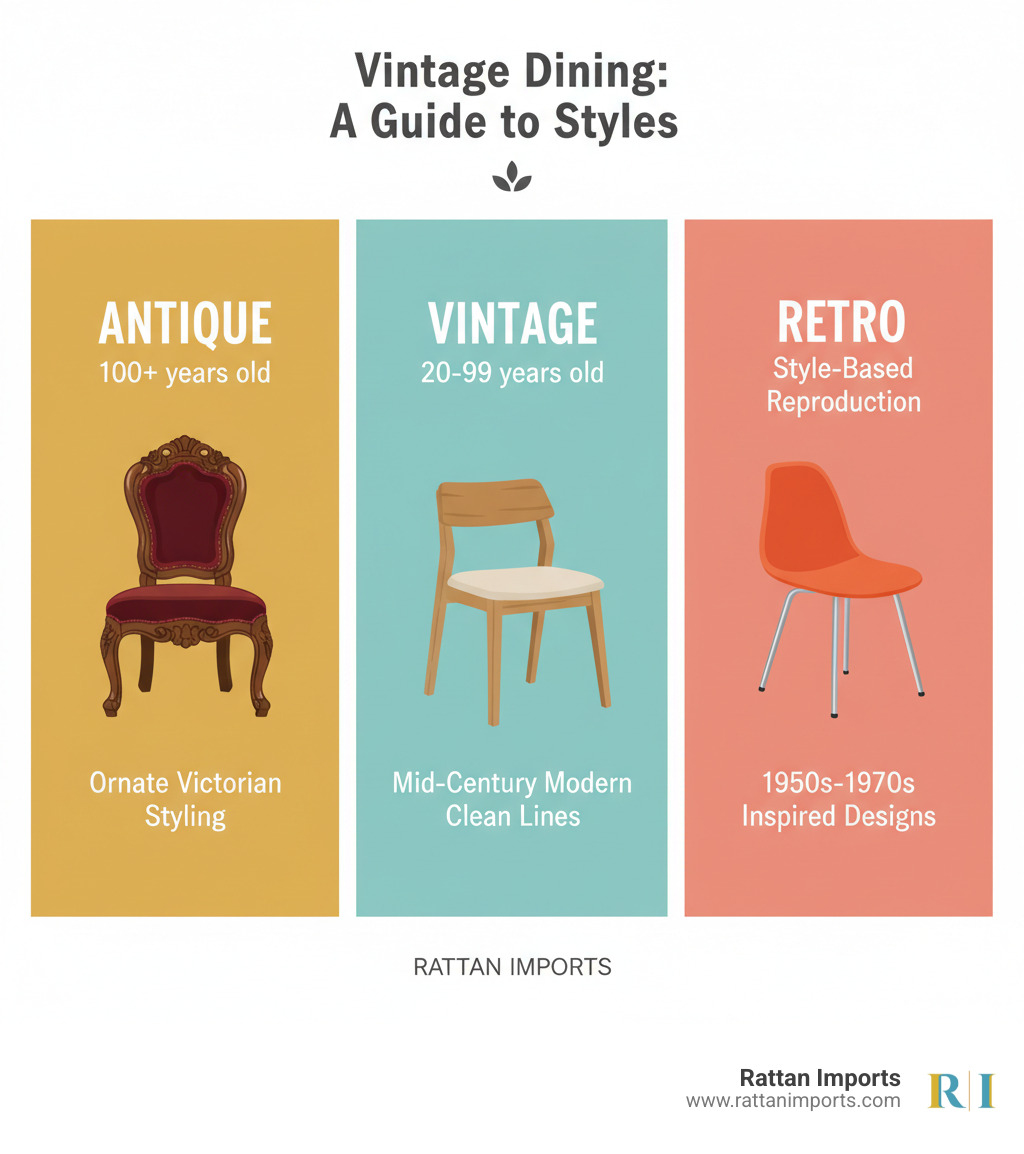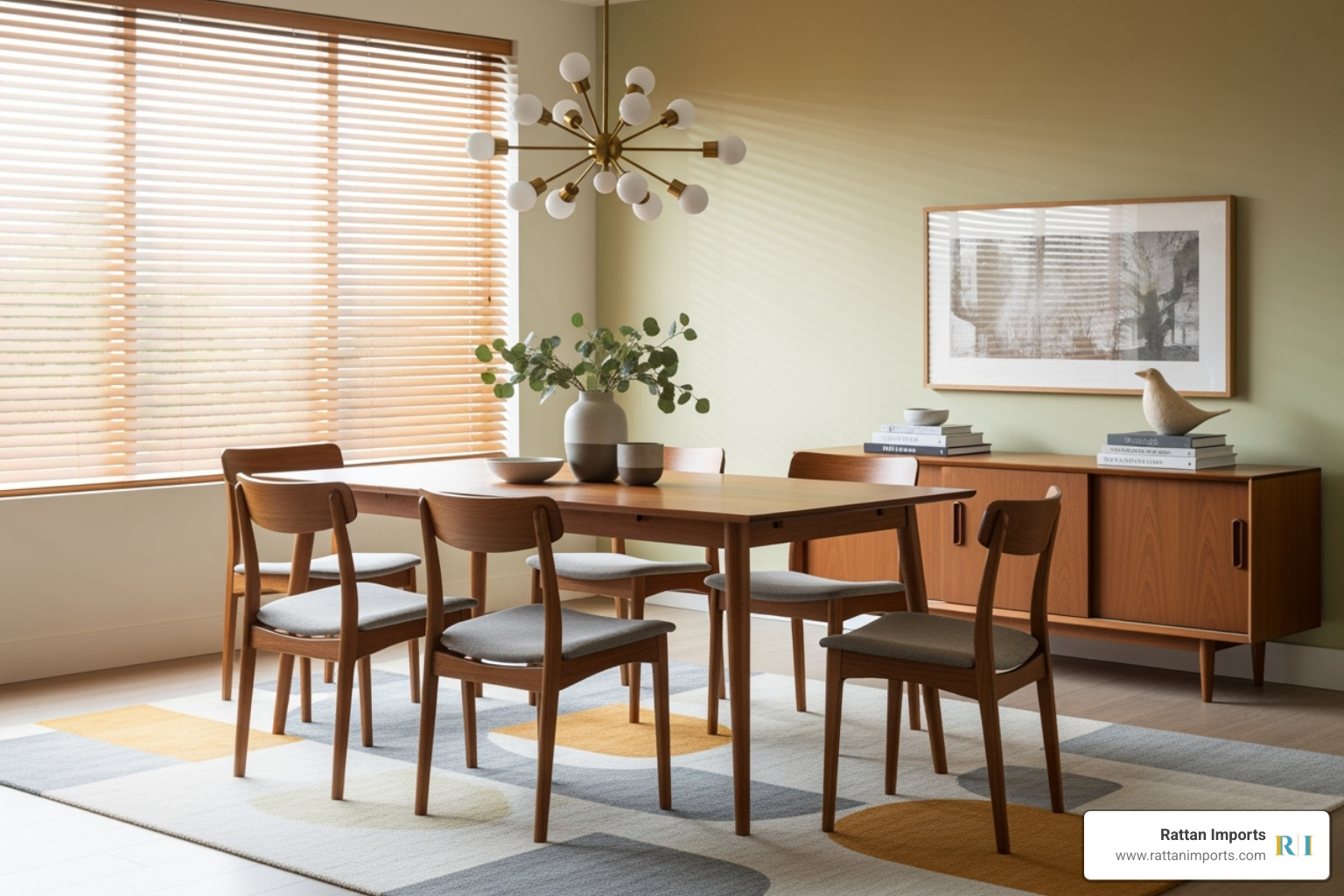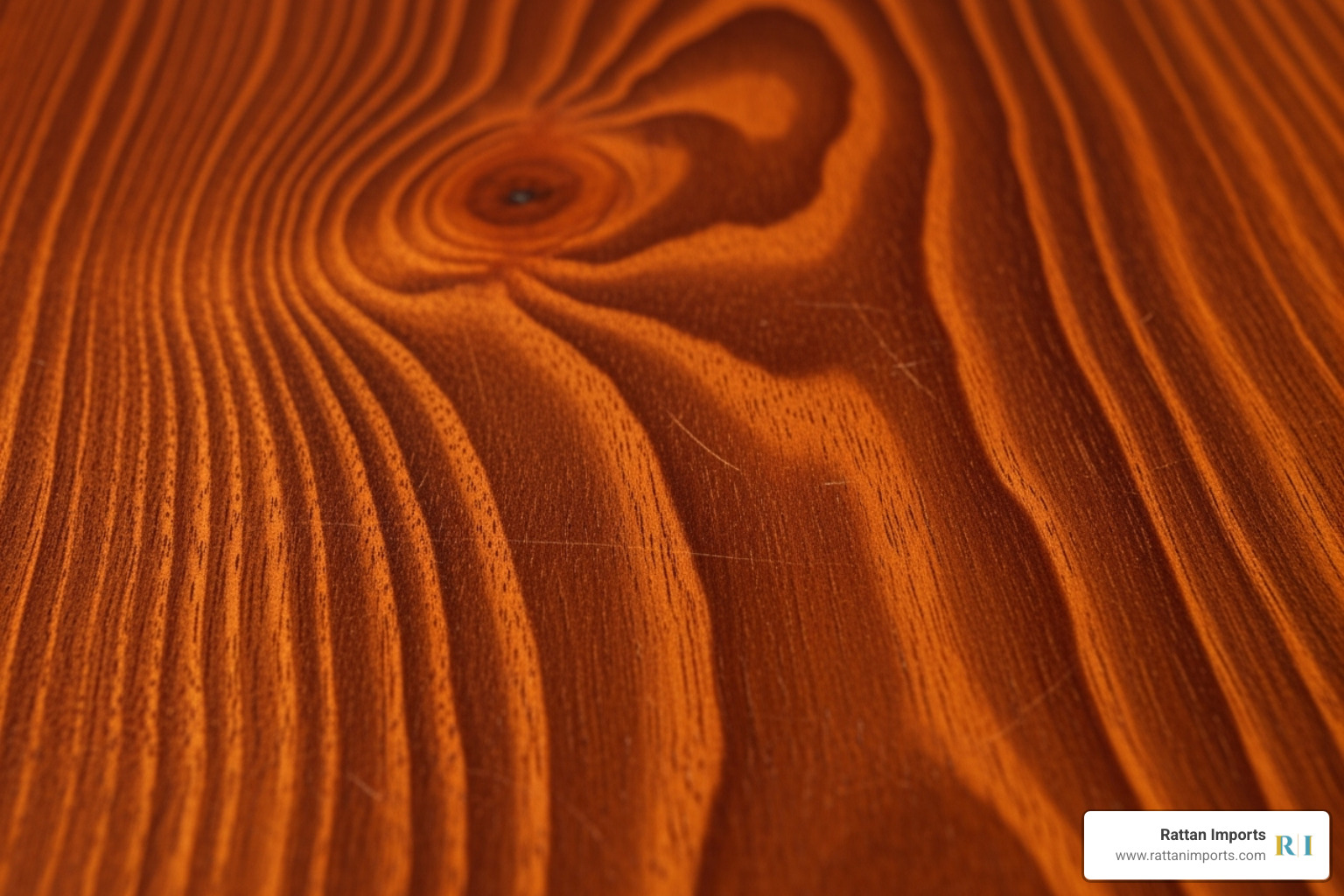Why Vintage Dining Transforms Your Home
Vintage dining brings character, sustainability, and superior craftsmanship into your home. Unlike mass-produced furniture, vintage pieces tell a story, with each mark representing decades of shared meals and gatherings.
What You Need to Know:
- Vintage: 20-99 years old
- Antique: 100+ years old
- Retro: Modern pieces imitating past styles (often 1950s-1970s)
- Key Benefits: Sustainability, unique character, superior craftsmanship, and value.
The vintage furniture market is surging as consumers recognize the durability and environmental benefits of secondhand pieces. The global antique furniture market, valued at $11.5 billion in 2022, is projected to reach $17.8 billion by 2030. This growth is visible across online marketplaces, independent dealers, and design communities, with increased interest in vintage dining across categories. The Environmental Protection Agency highlights how choosing reused furniture helps reduce waste and conserve natural resources.
I'm Nino Russo Alesi, founder of Rattan Imports. My Italian heritage taught me the value of gathering around well-crafted furniture. I've helped countless interior designers and homeowners find vintage dining pieces that create special moments. This guide will walk you through defining vintage styles, identifying quality materials, sourcing authentic pieces, and styling them in a modern home.

Tip 1: Understand What Makes Furniture "Vintage"
Not every old table is "vintage." Understanding the terminology helps you shop smarter. A piece is vintage if it's between 20 and 99 years old, capturing styles from the 1920s to the early 2000s. Once it crosses 100 years, it becomes an antique—a historical artifact often requiring specialized care. Retro pieces are new but made to look old, usually mimicking 1950s-70s styles. While charming, retro items lack the authentic history and craftsmanship of true vintage.
Why choose genuine vintage over new?
- Character: A vintage dining table tells a story through its unique patina and wear patterns—a lived-in beauty a factory-fresh table can't replicate.
- Craftsmanship: Most vintage furniture was built to last, using solid wood and durable joinery techniques like dovetail or mortise and tenon joints, unlike the staples and glue common today.
- Sustainability: Choosing vintage gives a beautiful piece a second life, keeping it from a landfill and reducing demand for new materials. It's a stylish way to make your home more eco-conscious.
- Value: Many vintage tables offer superior quality and timeless design for prices comparable to or less than mass-produced furniture. The growing market, projected to reach $17.8 billion by 2030, reflects consumers recognizing this value.
If you're drawn to round tables, our guide, "Timeless Treasures: A Buyer's Guide to Antique & Vintage Circular Dining Tables," offers more specific insights.
Tip 2: Explore Popular Styles & Eras
Once you know what vintage means, the fun begins: exploring the styles that shaped vintage dining design. Recognizing these periods helps you identify what speaks to you.

- Mid-Century Modern (1940s-1960s): The undisputed champion, known for clean lines, tapered legs, organic shapes, and rich woods like teak or walnut. Designers like Milo Baughman created pieces that blend form and function, remaining highly sought after.
- Art Deco (1920s-1930s): Reflecting the Jazz Age, this style features geometric patterns, chrome, glass, and exotic veneers. These are bold, glamorous statement pieces.
- French Country (18th-19th Centuries): Though often antique, this style's appeal is timeless. Look for distressed finishes, curved cabriole legs, and warm, handcrafted details on oak or fruitwood farm tables.
- Victorian (1837-1901): The opposite of minimalism, these are grand, ornate pieces with intricate carvings, dark mahogany or walnut, and heavy construction built to impress.
- Arts & Crafts (1880s-1920s): A reaction against Victorian excess, this movement celebrated honest craftsmanship with simple forms, visible joinery, and natural oak.
To identify an era, look at the legs: tapered suggests Mid-Century, heavily carved points to Victorian. The wood is another clue, with teak common in Mid-Century and oak in Arts & Crafts. The overall vibe—sleek and minimal versus ornate and decorative—will guide you. See how vintage aesthetics blend with modern sensibilities in our article on discovering modern dining table styles.
Tip 3: Master the Materials
The materials of a vintage dining table reveal its history, quality, and durability. Understanding them helps predict how a piece will age and perform.

Traditional Woods
- Oak: A workhorse found in Arts & Crafts and French Country pieces. It's incredibly strong and develops a gorgeous patina.
- Walnut: Known for its rich, dark color and beautiful grain, it was a favorite of Mid-Century Modern designers.
- Mahogany: This fine-grained wood has a classic reddish-brown warmth, often used in neat Victorian and Empire-style tables.
- Teak: A Mid-Century staple, teak is naturally resistant to moisture and pests, making it one of the most durable vintage options.
- Rosewood: Valued for its striking grain, it was used in high-end Mid-Century furniture. It's dense but can show scratches.
- Pine and Fruitwood: These softer woods bring rustic charm to farmhouse-style tables, developing a lovely aged patina.
Beyond Wood
Vintage tables often mix materials. Chrome and glass were popular in Art Deco and Mid-Century designs. Marble and stone add luxury to pieces like French bistro tables but require sealing to prevent stains. Iron and brass provide strength and decorative detail in table bases, while laminates like Formica offer a durable, colorful retro vibe from the 1950s.
The Appeal of Rattan and Wicker
At Rattan Imports, we love rattan and wicker for the unique texture and lightweight feel they bring to vintage dining. A rattan table base or wicker chairs add warmth without weight, creating a relaxed yet refined atmosphere. Rattan is surprisingly durable and ages gracefully, fitting beautifully in both classic and contemporary spaces. Learn more in our guides on wicker and rattan furniture and how to elevate your dining experience with rattan table bases.
Tip 4: The Thrill of the Hunt: Sourcing Your Piece
Searching for the perfect vintage dining table is a treasure hunt. Thanks to vintage furniture's popularity, you have more options than ever.
Where to Look
- Online Marketplaces: Curated platforms offer vast selections, filterable by era, material, and style. You can find everything from Chinese Chippendale sets to Drexel Meridian tables.
- Antique Shops & Malls: These stores let you touch the wood, test stability, and get a true sense of scale. Dealers are often passionate experts with stories to share.
- Flea Markets & Estate Sales: For the adventurous, these can yield incredible finds at great prices. Arrive early, bring a measuring tape, and be ready to act fast.
Mastering the Online Search
Be specific. Instead of "vintage table," search for "Danish modern teak dining table," "French farm table 19th century," or by designer, like "Milo Baughman chrome dining table." This helps you cut through the noise and find what you're looking for.
Why In-Person Viewing Matters
While online shopping is convenient, seeing a piece in person is invaluable. Photos can hide flaws or misrepresent scale. In person, you can check for wobbles, feel the wood grain, and appreciate the true patina. Plus, you can often negotiate the price.
Essential Questions for Any Seller
Whether online or in person, ask about:
- Condition: Request detailed photos of any scratches, water rings, or repairs.
- Dimensions: Get the length, width, and crucial knee clearance. For extending tables, ask for both closed and open measurements.
- History & Materials: Is there a maker's mark? What type of wood is it? Has it been restored?
- Logistics: Always clarify shipping or delivery options and costs for online purchases.
Tip 5: Inspect Like a Pro: Ensuring Quality and Authenticity
When hunting for a vintage dining table, look beyond aesthetics to ensure quality and structural integrity. A careful inspection saves you from future headaches.
Your Quality Checklist:
- Stability: Gently push on the tabletop. Significant wobbling indicates loose joints that may need professional repair.
- Joinery: Look for quality construction like dovetail or mortise and tenon joints. Be wary of pieces held together mainly by staples or modern screws, which can signal lower quality.
- Surface Condition: Examine the tabletop for its patina—the desirable aging and wear. Minor scratches are fine, but check for lifting veneer, deep gouges, or dark water stains that may be permanent.
- Legs & Extensions: Ensure legs are securely attached and free of cracks. If the table extends, test the mechanism for smooth operation and a snug fit.
- Knee Clearance: This is a crucial comfort factor. Measure the space from the floor to the apron beneath the tabletop. A clearance of around 24 inches is typical, but ensure it's enough for you.
Authenticity & Red Flags
Look for maker's marks or labels from reputable manufacturers like Heywood Wakefield or Drexel. Authentic wear should be consistent with age, appearing on edges or where hands would rest.
Avoid pieces with these red flags:
- Major structural damage: Large cracks, breaks, or significant woodworm infestation.
- Persistent musty odor: This can indicate mold or rot, which is unhealthy and hard to eliminate.
- Poorly executed repairs: Sloppy glue jobs or mismatched patches devalue a piece and may need to be redone.
By examining these details, you can confidently choose a high-quality vintage dining table. For more tips, our "Complete Guide to Choosing the Perfect Wicker Dining Table" has insights applicable to many vintage pieces.
Tip 6: Styling Your Vintage Dining Table in a Modern Home
The secret to styling vintage dining pieces is mastering the art of mixing old and new. This blend creates spaces that feel timeless and fresh, not stuffy.

Imagine a weathered 19th-century farm table surrounded by sleek modern chairs. The contrast is striking: the table's rustic warmth highlights the chairs' clean lines, preventing the room from feeling dated. This juxtaposition is what makes vintage so compelling. The same principle applies to pairing a vintage table with a sculptural modern pendant light or a contemporary geometric rug. The result is a curated space that reflects your personal style.
Pairing with Modern Chairs
Chairs are transformative. The right pairing can make or break the look. The key is often contrast with purpose.
- Wicker and Rattan: Our favorites at Rattan Imports, these chairs add natural texture and an airy quality that balances substantial wood tables. They bring lightness without sacrificing warmth. Our guides on wicker and rattan dining chairs and modern rattan dining chairs show their versatility.
- Metal, Acrylic, or Upholstered: Metal chairs add an industrial edge, while clear acrylic "ghost" chairs let the table shine. Upholstered chairs offer comfort and a chance to add color or a neutral counterpoint.
If your table is ornate, choose simple chairs. If your table is minimalist, you can be bolder with your chair choice. For more ideas, see our article on the best chairs for kitchen tables.
Accessorizing Your Setup
Accessories add personality. Layer modern plates on vintage chargers, or pair antique silverware with contemporary linens. For a centerpiece, opt for a simple glass vase or a modern sculpture that complements, not hides, the table. For wall decor, consider modern art or unique vintage menu art for a conversation starter. You can also find inspiration with vintage dinnerware, but be aware that older pieces may not be microwave-safe and should be hand-washed.
Tip 7: Care, Maintenance, and Simple Repairs
A vintage dining table is an heirloom in the making. With thoughtful care, it can serve your family for generations.
Daily Care for Your Vintage Table
Simple, consistent habits are key to preserving your vintage piece.
- Cleaning: Use a soft, damp cloth to wipe surfaces, followed immediately by a dry cloth. Avoid harsh chemical cleaners or abrasive scrubs that can strip the finish. For wood, a thin layer of paste wax applied as needed offers gentle cleaning and protection.
- Protection: Always use coasters, placemats, and trivets for hot dishes. Prevention is the best way to avoid water rings, heat marks, and scratches.
- Environment: Keep your table out of direct sunlight and away from extreme temperature or humidity swings to prevent fading, drying, and warping.
Handling Common Repairs
Know which fixes you can tackle and when to call a professional.
- DIY Fixes: Light scratches can often be minimized with wax repair sticks or by rubbing a walnut over the mark. White water rings may be removed with a gentle application of mayonnaise or a baking soda paste (always test on an inconspicuous spot first). Tightening loose screws on hardware is also an easy fix.
- When to Call a Pro: For significant wobbles from loose joinery, large areas of damaged veneer, or major structural issues like cracks and breaks, consult a professional furniture restorer. If you suspect woodworm (tiny holes and fine powder), seek expert help immediately to prevent it from spreading.
Different materials have unique needs. Our guide, "Wicker Dining Room Sets: Style Meets Function," offers specialized advice for natural materials.
Frequently Asked Questions about Vintage Furniture
Here are answers to common questions we hear from customers exploring vintage dining.
How can I tell if a vintage table is a good investment?
A good investment typically has four qualities: solid wood construction, a reputable maker (like Heywood Wakefield or Drexel), good condition (charming patina, not structural damage), and a timeless style (like Mid-Century Modern or French Country). A table with this foundation can be repaired and refinished, holding its value for years.
Can I use a vintage dining table for everyday family meals?
Absolutely! Many vintage dining tables, especially those from solid hardwoods, were built to withstand daily family life. An oak farm table or a solid walnut Mid-Century piece can handle the hustle. The key is to use placemats and coasters as a first line of defense and to wipe up spills immediately. These tables have already survived decades; with basic care, they'll serve your family for many more.
What's the best way to pair chairs with a vintage dining table?
The magic formula is that contrast creates interest. Pair an ornate Victorian or French Country table with sleek, simple modern chairs (in wicker, metal, or a streamlined design) to keep the look fresh. Conversely, a minimalist Mid-Century table can handle chairs with more personality, like those with bold fabric or a rich texture like rattan. If you prefer harmony, match a key element, like the wood tone or leg style, to create a cohesive look. Our guide on the best chairs for kitchen tables offers more inspiration.
Conclusion
We've journeyed through vintage dining, from defining styles and inspecting quality to styling and caring for your perfect table. Choosing vintage is about more than just furniture; it's about embracing sustainability, character, and craftsmanship. It's about creating a gathering place where new memories will unfold around a table that already holds decades of its own.
Accept the character your vintage table brings—the gentle wear, the unique wood grain, the rich patina. These aren't flaws; they are the essence of what makes your piece special.
Here at Rattan Imports, we share that dedication to quality and personality. We source premium furniture and believe in making your journey easy with free U.S. shipping, a price guarantee, and exceptional customer service. Whether you're drawn to Mid-Century teak or the natural elegance of rattan, a vintage-inspired piece is waiting to become the heart of your home.
Explore our curated collection of dining sets to find the perfect centerpiece for your home. Let's create a space where your family and friends will gather for years to come.


